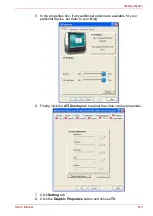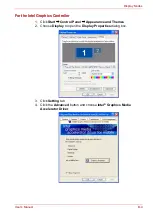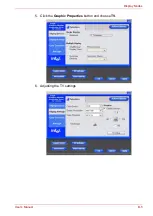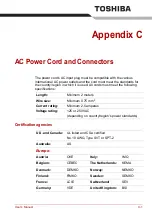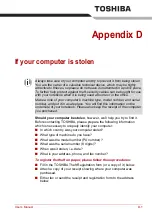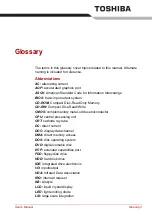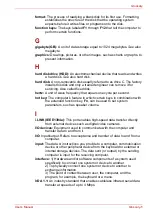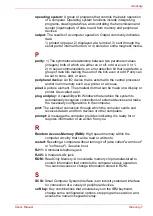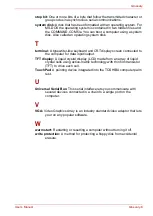
User’s Manual
Glossary-6
Glossary
J
jumper:
A small clip or wire that allows you to change the hardware
characteristics by electrically connecting two points of a circuit.
K
K:
Taken from the Greek word kilo, meaning 1000; often used as equivalent
to 1024, or 2 raised to the 10th power.
See also
byte and kilobyte.
KB:
See
kilobyte.
L
Light Emitting Diode (LED):
A semiconductor device that emits light when
a current is applied.
Liquid Crystal Display (LCD):
Liquid crystal sealed between two sheets of
glass coated with transparent conducting material. The viewing-side
coating is etched into character forming segments with leads that
extend to the edge of the glass. Applying a voltage between the
glass sheets alters the brightness of the liquid crystal.
LSI:
Large Scale Integration.
1) A technology that allows the inclusion of up to 100,000 simple
logic gates on a single chip.
2) An integrated circuit that uses large scale integration.
M
megabyte (MB):
A unit of data storage equal to 1024 kilobytes.
See also
kilobyte.
mode:
A method of operation, for example, the boot mode, standby mode
or the hibernation mode.
modem:
Derived from modulator/demodulator, a device that converts
(modulates) digital data for transmission over telephone lines and
then converts modulated data (demodulates) to digital format where
received.
monitor:
A device that uses rows and columns of pixels to display
alphanumeric characters or graphic images.
See also
CRT.
MP3:
An audio compression standard that enables high-quality
transmission and real-time playback of sound files.
N
numeric keypad overlay:
A feature that allows you to use certain keys on
the keyboard to perform numeric entry, or to control cursor and page
movement.
O



